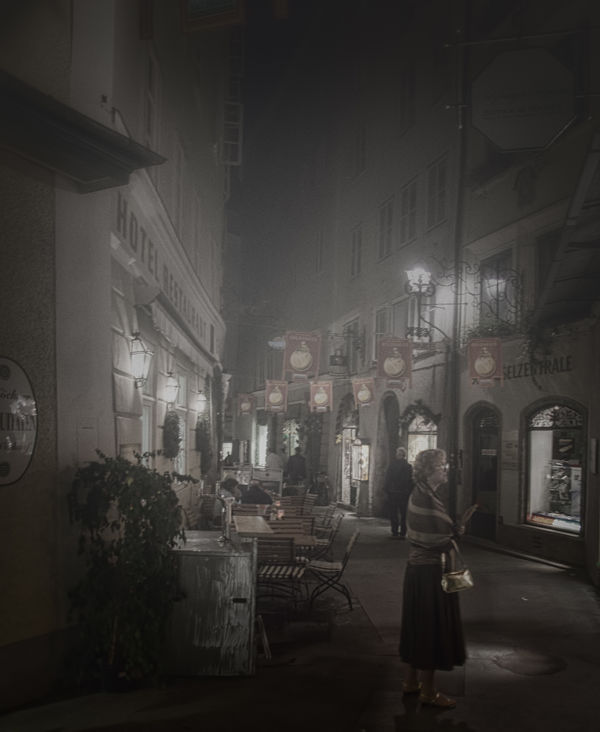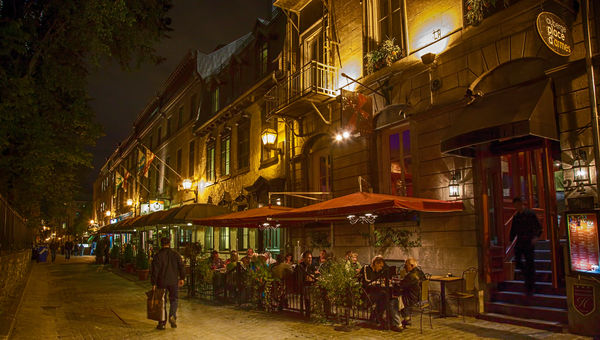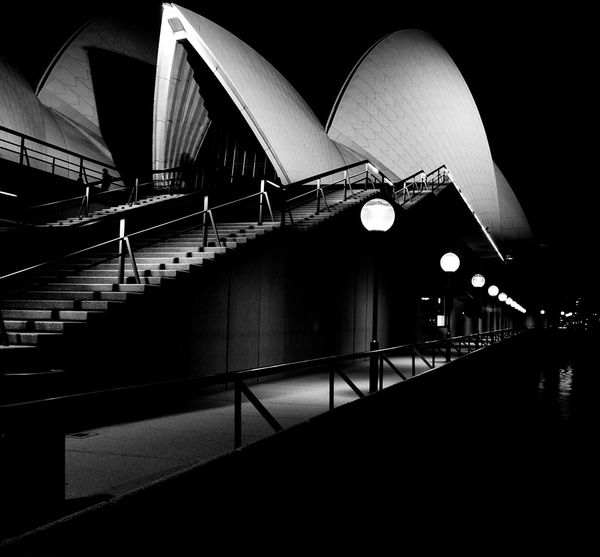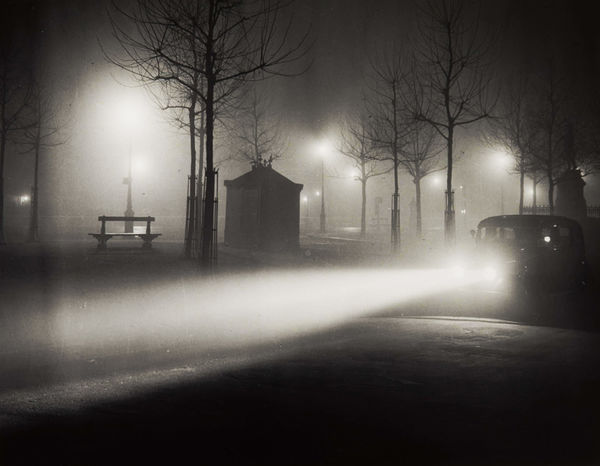Monthly Masters' Critique - August 2020 - Brassai's Urban Night Photograph "Avenue del Observatoire"
Aug 1, 2020 10:17:46 #
Introduction
Gyula Halasz, better known by his pseudonym Brassai, was born in Transylvania in 1899. He moved to Paris in 1924 to become a journalist but soon became interested in photography as a way to record encounters on his nightly walks through the streets of Paris.The photographs he took during this period were published in 1933 in his book “Paris de Nuit”, a stunning collection of black and white images that juxtaposed luminous, dreamlike nightscapes with contemporary documentary images of the nighttime’s denizens. His work attracted attention as a technical marvel as well, for he was one of the first photographers to shoot extensively at night."Night does not show things, it suggests them. It disturbs and surprises us with its strangeness."
Brassai worked commercially for Harpers Bazaar, and collected a variety of honors for his film work and his writing, as well as for his photography. His work is exhibited in galleries worldwide, including MOMA, and he was inducted into the International Photography Hall of fame in 1979.
Review some of the linked information to learn more about Brassai and view his other photographic work, which is quite varied, ranging from portraits to abstracts, nudes to landscapes, and a wide range of street photography. Then share your opinion of the posted photograph. Below are some questions to spur your thinking.
Questions to Consider
1. What is your opinion of this image? Does it have impact? Why or why not? What do you make of the composition? The tonalities? Would you want it in your own art collection? Why or why not?
2. Would this image be more or less interesting without the fog? How does atmosphere contribute to our images? If you’d like, share an image of your own where, in your opinion, atmospherics contributed to its success.
3. It has been said that photography is “all about the light”. Usually when we hear that statement, we assume it refers to natural light. Brassai used a variety of manmade lighting of the urban landscape to advantage in many of his images. What do you think of Brassai’s use of light in this particular image? If you have used urban lighting to help create a night photograph, please share and discuss.
4. In night photography there are often areas of the image that are allowed to lose all detail. For a viewer, how does lack of detail in darkness differ from lack of detail due in unfocused areas? Are the functions of low detail areas similar regardless of the cause? Discuss.
Links To Explore
https://www.imaging-resource.com/news/2014/01/07/the-piercing-eye-of-brassai-a-brief-history-of-a-master-photographer
https://en.wikipedia.org/wiki/Brassa%C3%AF
https://photographyicon.com/brassai/
https://iphf.org/inductees/brassai/
https://theculturetrip.com/europe/france/paris/articles/brassa-the-eye-of-paris-and-his-hungarian-soul/
http://www.visual-arts-cork.com/photography/brassai.htm
http://famous-photographers.com/brassai/
https://www.atgetphotography.com/The-Photographers/BRASSAI.html
Gyula Halasz, better known by his pseudonym Brassai, was born in Transylvania in 1899. He moved to Paris in 1924 to become a journalist but soon became interested in photography as a way to record encounters on his nightly walks through the streets of Paris.The photographs he took during this period were published in 1933 in his book “Paris de Nuit”, a stunning collection of black and white images that juxtaposed luminous, dreamlike nightscapes with contemporary documentary images of the nighttime’s denizens. His work attracted attention as a technical marvel as well, for he was one of the first photographers to shoot extensively at night."Night does not show things, it suggests them. It disturbs and surprises us with its strangeness."
Brassai worked commercially for Harpers Bazaar, and collected a variety of honors for his film work and his writing, as well as for his photography. His work is exhibited in galleries worldwide, including MOMA, and he was inducted into the International Photography Hall of fame in 1979.
Review some of the linked information to learn more about Brassai and view his other photographic work, which is quite varied, ranging from portraits to abstracts, nudes to landscapes, and a wide range of street photography. Then share your opinion of the posted photograph. Below are some questions to spur your thinking.
Questions to Consider
1. What is your opinion of this image? Does it have impact? Why or why not? What do you make of the composition? The tonalities? Would you want it in your own art collection? Why or why not?
2. Would this image be more or less interesting without the fog? How does atmosphere contribute to our images? If you’d like, share an image of your own where, in your opinion, atmospherics contributed to its success.
3. It has been said that photography is “all about the light”. Usually when we hear that statement, we assume it refers to natural light. Brassai used a variety of manmade lighting of the urban landscape to advantage in many of his images. What do you think of Brassai’s use of light in this particular image? If you have used urban lighting to help create a night photograph, please share and discuss.
4. In night photography there are often areas of the image that are allowed to lose all detail. For a viewer, how does lack of detail in darkness differ from lack of detail due in unfocused areas? Are the functions of low detail areas similar regardless of the cause? Discuss.
Links To Explore
https://www.imaging-resource.com/news/2014/01/07/the-piercing-eye-of-brassai-a-brief-history-of-a-master-photographer
https://en.wikipedia.org/wiki/Brassa%C3%AF
https://photographyicon.com/brassai/
https://iphf.org/inductees/brassai/
https://theculturetrip.com/europe/france/paris/articles/brassa-the-eye-of-paris-and-his-hungarian-soul/
http://www.visual-arts-cork.com/photography/brassai.htm
http://famous-photographers.com/brassai/
https://www.atgetphotography.com/The-Photographers/BRASSAI.html
Aug 2, 2020 14:21:38 #
1. What is your opinion of this image? Does it have impact? Why or why not? What do you make of the composition? The tonalities? Would you want it in your own art collection? Why or why not?
I like this image very much, mainly because of the atmosphere. I would have it in my own art collection.
2. Would this image be more or less interesting without the fog? How does atmosphere contribute to our images? If you’d like, share an image of your own where, in your opinion, atmospherics contributed to its success.
I think it would be very less interesting without the fog (or rain). As one of my friends, who is a landscape photographer, once said "some of my best imagews have be taken whilst standing under an umbrella".
Here is a vacation "street" photograph, in Salzburg (Austria), where the fog has been added when post processing. The lady is my fabvourite model.
Photographing motor racing in the rain was one of my great joys (I can post another image with your permission)
3. It has been said that photography is “all about the light”. Usually when we hear that statement, we assume it refers to natural light. Brassai used a variety of manmade lighting of the urban landscape to advantage in many of his images. What do you think of Brassai’s use of light in this particular image? If you have used urban lighting to help create a night photograph, please share and discuss.
I strongly agree, and I love his use of light.
Here is another vacation shot in Quebec city. I have a few examples like this.
4. In night photography there are often areas of the image that are allowed to lose all detail. For a viewer, how does lack of detail in darkness differ from lack of detail due in unfocused areas? Are the functions of low detail areas similar regardless of the cause? Discuss.
The lack of detail in darkness allows you to emphasise form. An example is the Sydney opera house.
I use shallow dof to isolate the subject in reasonable light levels. Low light levels can achieve the same thing - as per my opera house photograph.
.
I like this image very much, mainly because of the atmosphere. I would have it in my own art collection.
2. Would this image be more or less interesting without the fog? How does atmosphere contribute to our images? If you’d like, share an image of your own where, in your opinion, atmospherics contributed to its success.
I think it would be very less interesting without the fog (or rain). As one of my friends, who is a landscape photographer, once said "some of my best imagews have be taken whilst standing under an umbrella".
Here is a vacation "street" photograph, in Salzburg (Austria), where the fog has been added when post processing. The lady is my fabvourite model.
Photographing motor racing in the rain was one of my great joys (I can post another image with your permission)
3. It has been said that photography is “all about the light”. Usually when we hear that statement, we assume it refers to natural light. Brassai used a variety of manmade lighting of the urban landscape to advantage in many of his images. What do you think of Brassai’s use of light in this particular image? If you have used urban lighting to help create a night photograph, please share and discuss.
I strongly agree, and I love his use of light.
Here is another vacation shot in Quebec city. I have a few examples like this.
4. In night photography there are often areas of the image that are allowed to lose all detail. For a viewer, how does lack of detail in darkness differ from lack of detail due in unfocused areas? Are the functions of low detail areas similar regardless of the cause? Discuss.
The lack of detail in darkness allows you to emphasise form. An example is the Sydney opera house.
I use shallow dof to isolate the subject in reasonable light levels. Low light levels can achieve the same thing - as per my opera house photograph.
.
#1 Salzburg - after the concert.

(Download)
#2 Quebec city.

(Download)
#3 Sydney opera house.

(Download)
Aug 2, 2020 22:05:39 #
RichardTaylor wrote:
1. What is your opinion of this image? Does it hav... (show quote)
Thanks Richard for a thorough assessment and especially for the interesting images. You are so right about the lack of detail in dark areas allowing you to emphasize form. You've used that technique well in your Opera house image, and what a great subject it is to present that way!
Aug 3, 2020 06:30:38 #
Thanks for another interesting subject and list of thought-provoking questions.
Looking at some of his other B&W shots, they all seem to be a bit on the soft side, which presumably is due to the limitations of the photographic medium. For a daylight B&W that would usually be a negative because contrast is usually an essential ingredient of B&W. However, in this case, not only is it a night shot, it's also a misty shot and the lack of vivid contrast becomes a positive.
Dark areas play a very similar role to the OOF areas caused by shallow DOF, but to my mind there are subtle differences. For a daytime shot a lack of sharp focus is usually enough to prevent an area from becoming a distraction, but in a nighttime shot the obscuring of detail needs to be more extreme. In a nighttime shot (and also a misty shot) the obscure areas provide us with blank spaces which give our imaginations the opportunity to fill in the blanks, and in doing so those detail-free areas can add significantly to the atmosphere of the scene. With a daytime shot, if the OOF areas are not distracting, that is considered sufficient and it is not essential to remove all recognisable detail. In fact recognisable detail in the softer areas can be used to add to the storytelling and can also tell us something about the context. For a nighttime shot the shadows need to be more impenetrable in order to achieve their effect.
Looking at some of his other B&W shots, they all seem to be a bit on the soft side, which presumably is due to the limitations of the photographic medium. For a daylight B&W that would usually be a negative because contrast is usually an essential ingredient of B&W. However, in this case, not only is it a night shot, it's also a misty shot and the lack of vivid contrast becomes a positive.
Dark areas play a very similar role to the OOF areas caused by shallow DOF, but to my mind there are subtle differences. For a daytime shot a lack of sharp focus is usually enough to prevent an area from becoming a distraction, but in a nighttime shot the obscuring of detail needs to be more extreme. In a nighttime shot (and also a misty shot) the obscure areas provide us with blank spaces which give our imaginations the opportunity to fill in the blanks, and in doing so those detail-free areas can add significantly to the atmosphere of the scene. With a daytime shot, if the OOF areas are not distracting, that is considered sufficient and it is not essential to remove all recognisable detail. In fact recognisable detail in the softer areas can be used to add to the storytelling and can also tell us something about the context. For a nighttime shot the shadows need to be more impenetrable in order to achieve their effect.
Aug 3, 2020 10:04:11 #
R.G. wrote:
Thanks for another interesting subject and list of... (show quote)
Thanks for sharing! I suspect you are right about the technology of the day contributing to the softness of detail. But perhaps the softness was for him a feature and not a bug, and perhaps he used it to advantage. Certainly a lot of his nightscapes include atmospheric blur from fog or haze. As technology has advanced, so has our taste for sharpness in photographs.
Enjoyed your view on the use of dark area vs intentional OOF as contributory elements of composition.
If you want to reply, then register here. Registration is free and your account is created instantly, so you can post right away.



